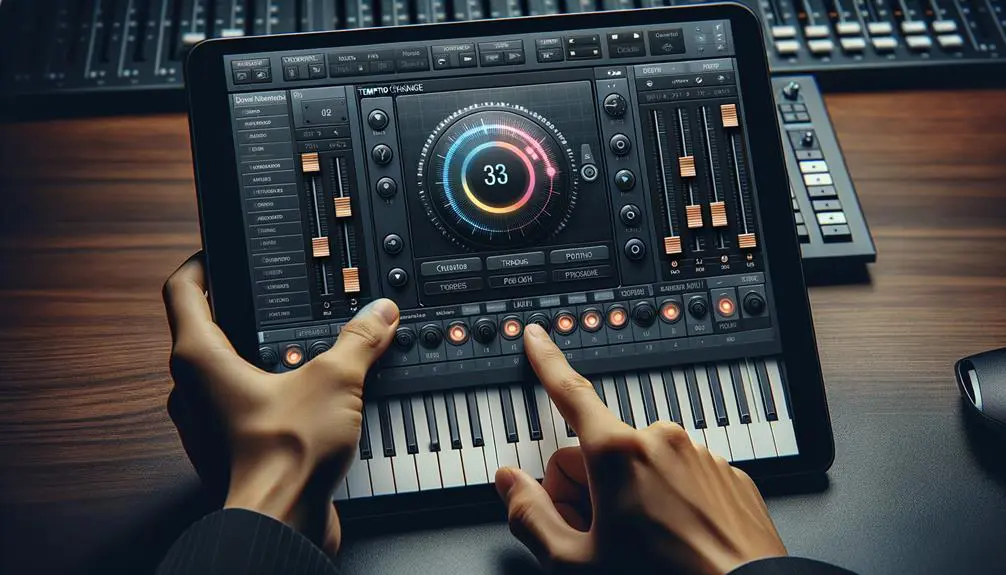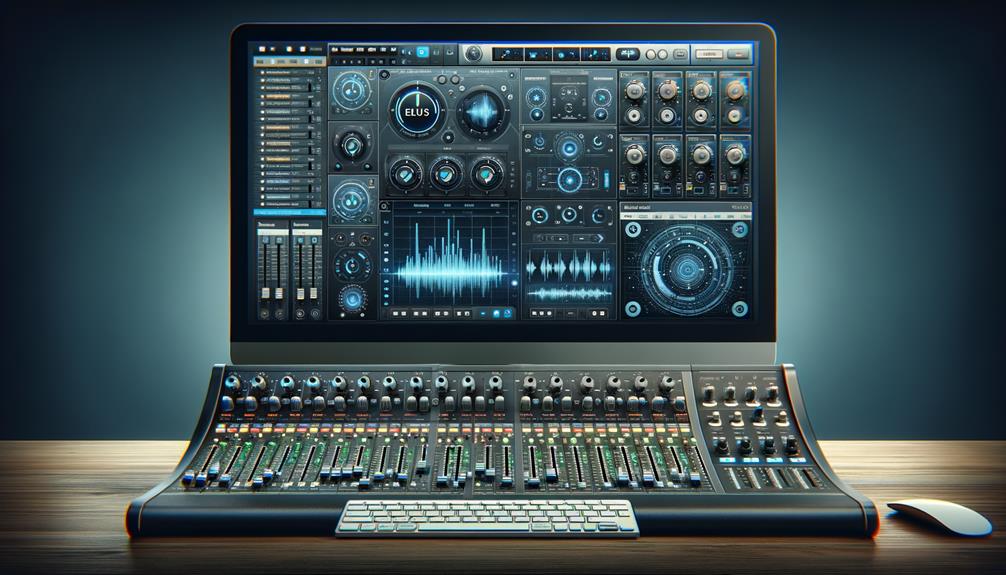To change the BPM in Logic Pro X, first grasp the importance of BPM in shaping your track’s energy. Begin by selecting the relevant audio files using Shift + Click to guarantee timing integrity. Access Flex Time by pressing “1F” and choose an appropriate algorithm, such as Polyphonic, for smooth adjustments. Enter the desired BPM in the transport bar or drag the tempo marker. Test the new BPM during playback to evaluate its impact. Avoid drastic changes to maintain audio quality. By following these steps, you’ll optimize your session for coherence and artistry, while discovering further techniques to enhance your production.
Key Takeaways
- Open your project in Logic Pro X and identify the current BPM displayed in the transport bar for reference.
- Use Shift + Click to highlight all audio tracks you want to adjust, ensuring timing integrity during tempo changes.
- Press “1F” to enter Flex Time mode and choose the Polyphonic algorithm for accurate audio adjustments.
- Adjust tempo by dragging the tempo marker or entering a new BPM value in the transport bar, keeping changes within 10-15 BPM for optimal quality.
- Regularly test your audio during playback to evaluate the impact of BPM adjustments on creativity and overall sound quality.
Understand BPM Importance
The significance of BPM (beats per minute) in music production cannot be overstated, as it serves as the foundational element that dictates the tempo and overall feel of a track.
Understanding BPM is vital for creating engaging music; an initial setting that feels slow can stifle creativity. As a result, adjusting the tempo to make it a bit faster can enhance the session’s energy and rhythm.
Small modifications, typically between 10-15 BPM, can greatly improve audio quality while avoiding distortion. Additionally, precise BPM settings are essential; even slight discrepancies, such as 103.6 versus 103, can impact the coherence and sound of the session. Implementing techniques like surgical EQ cuts can further enhance clarity in your mixes.
Mastering BPM adjustments ultimately leads to more polished and professional music productions.
Select Audio Files
To begin the process of changing the BPM in Logic Pro X, it is vital to select the desired audio files efficiently.
Utilizing the Shift + Click method allows for the simultaneous highlighting of multiple tracks, ensuring a streamlined workflow.
This step is imperative for maintaining timing integrity as adjustments are made to the tempo across all selected files. Additionally, a MIDI controller with pad sensitivity can greatly enhance your ability to manipulate audio files in real-time, providing a more dynamic production experience.
Highlighting Audio Tracks
Highlighting audio tracks in Logic Pro X is essential for effective tempo adjustments and guaranteeing that all elements of your project align with the new BPM. Employing various highlighting techniques facilitates audio organization and enhances session management. To select multiple tracks, hold down the Shift key while clicking on each audio file. For non-adjacent selections, use the Command key in conjunction with clicking. This method guarantees uniform application of changes, which is critical for maintaining session integrity. Once highlighted, you can easily access tempo adjustment options to modify the BPM without distorting the sound.
| Action | Description |
|---|---|
| Shift + Click | Select multiple adjacent audio files |
| Command + Click | Select multiple non-adjacent audio files |
| Highlight All | Quickly select all tracks in view |
| Deselect Tracks | Click on highlighted tracks to deselect |
| Access Tempo Options | Modify BPM efficiently |
Using Shift + Click
Efficiently selecting multiple audio files in Logic Pro X is vital for managing tempo changes effectively.
By utilizing the Shift + Click method, users can efficiently select individual audio tracks without impacting the entire session. To do this, simply hold down the Shift key while clicking on each desired audio file, ensuring that all relevant tracks are highlighted.
This efficient selection is imperative before making any tempo adjustments, as it guarantees consistent playback across your project. Additionally, always verify that the highlighted files align with the click track for accurate tempo changes.
Once selected, you can seamlessly apply the desired adjustments using the Flex Time feature, enhancing your audio management capabilities within Logic Pro X.
Access Flex Time
Accessing Flex Time in Logic Pro X involves a straightforward process that enhances your ability to manipulate audio tracks effectively.
Begin by selecting the desired audio track and pressing “1F” to enter Flex Time mode. This enables you to choose an appropriate Flex Time algorithm, such as Polyphonic, which is essential for accurate tempo adjustments while preserving audio quality.
To modify multiple tracks simultaneously, highlight the audio files using Shift + Click. Once in Flex Time, you can easily adjust the tempo by dragging the tempo marker on the timeline or by manually entering a new BPM in the transport bar.
Always test your new tempo settings to guarantee the click track remains aligned and the audio integrity is maintained. Additionally, understanding gain staging is crucial for ensuring optimal audio levels when changing BPM.
Choose Tempo Settings
Establishing the initial BPM is a foundational step in the production process within Logic Pro X, as it sets the tempo for your entire project. Adjusting the tempo during playback allows for real-time evaluation of how changes affect the overall sound and alignment with the click track. Careful management of these settings guarantees a polished and cohesive audio quality throughout your session. Additionally, utilizing the Tempo List editor can streamline your tempo adjustments for enhanced efficiency.
Setting Initial BPM
Setting the initial BPM in Logic Pro X is a fundamental step that influences the overall pace and feel of your project. To establish this, locate the tempo display in the control bar at the top of the window. Input your desired BPM directly by clicking on the display and typing the value.
It’s essential to select an appropriate BPM to guarantee the alignment of audio files and enhance the session’s feel. Employ initial BPM strategies that align with comfortable BPM ranges, typically within 10-15 BPM adjustments from your original setting.
This approach not only guarantees a cohesive sound but also maximizes the project tempo impact, laying a solid foundation for your musical arrangement.
Adjusting During Playback
While working on a project in Logic Pro X, the ability to adjust the tempo during playback can greatly enhance your creative process.
To implement tempo adjustments techniques effectively, click on the tempo display in the control bar and input your desired BPM. Confirm that the “Follow Tempo” option is activated in the Transport settings to hear real time tempo changes immediately.
For gradual modifications, utilize the tempo track to insert changes at specific points in your project. For precise adjustments, the “Tempo Operations” window allows you to set specific BPMs for different sections.
However, be cautious with drastic BPM changes, as maintaining adjustments within a 10-15 BPM range guarantees ideal audio quality, enhancing your playback experience considerably.
Test New BPM
To effectively test a new BPM in Logic Pro X, begin by ensuring that all desired audio files are selected, which can be accomplished through the Shift + Click method. Next, access the Flex Time options by pressing “1F” and choose the Polyphonic setting to facilitate smooth tempo variations without compromising sound dynamics. Adjust the tempo to your desired BPM, such as shifting from 80 BPM to 90 BPM, and listen to the playback to assess the BPM effects on audio integrity. This process allows for precise control over the pacing of the track.
Here’s a table to summarize key steps:
| Step | Action |
|---|---|
| Select Audio Files | Shift + Click |
| Access Flex Time | Press “1F” |
| Choose Setting | Polyphonic |
| Adjust Tempo | Change BPM, listen and evaluate |
Fine-tune as necessary to achieve the best alignment with your click track.
Avoid Drastic Changes
Drastic changes in BPM should be avoided in Logic Pro X, as they can compromise the audio’s integrity and introduce unwanted artifacts.
Altering the tempo by more than 10-15 beats per minute can markedly impact the dynamics of your tracks, especially in polyphonic audio files. Such changes often result in unnatural sounds, detracting from the overall quality of the mix.
Instead, focus on subtle tempo adjustments that allow for smoother alignment with the click track, ensuring a cohesive sound throughout the session.
Always listen back to the modified audio to confirm that preserving audio integrity has been achieved without introducing distortion. Incorporating techniques like dynamic range control can further enhance the quality of your audio during the mastering process.
Maintaining minimal BPM changes is essential for retaining the original character and dynamics, vital for professional audio production.
Optimize for Quality
Maintaining audio integrity is vital when making tempo adjustments in Logic Pro X. To enhance for quality, confirm that you highlight all desired audio files before altering the BPM. This prevents misalignment and maintains mixing balance across your session. Utilize the Polyphonic setting in Flex Time for effective tempo adjustments that preserve audio fidelity. Additionally, precision in BPM settings is essential; even slight discrepancies can lead to noticeable variations in audio quality. Regularly testing different tempo settings can help you find the ideal BPM while guaranteeing tempo consistency throughout your project. Understanding the sampling rate and bit depth is also crucial, as it can impact the overall quality of your audio during these adjustments.
| Action | Benefits | Considerations |
|---|---|---|
| Highlight audio files | Confirms uniform adjustments | Avoids misalignment issues |
| Use Polyphonic Flex Time | Preserves audio integrity | May require additional tweaks |
| Test tempo settings | Identifies ideal BPM | Affects overall sound |
Frequently Asked Questions
How to Change Bpm on Logic Pro X?
To change BPM settings in Logic Pro X, access tempo adjustments through the Flex Time options. Confirm session preferences align with the new tempo, testing playback to maintain audio integrity and synchronization throughout your project.
How to Automate Bpm Logic?
To automate BPM effectively, utilize bpm automation techniques by creating automation points in the BPM track. Implement tempo mapping strategies for seamless shifts and employ dynamic tempo adjustments to enhance the musicality of your project.
How Do I Change the Bpm of an Audio File?
To effectively change the BPM of an audio file, utilize audio tempo adjustments and tempo mapping techniques. Guarantee precise audio file synchronization by adjusting tempo gradually, maintaining audio integrity and enhancing the overall quality of your session.
How Do You Change Tempo Gradually in Logic?
To implement gradual tempo changes, utilize tempo automation techniques alongside tempo mapping strategies. This approach allows for precise adjustments, ensuring smooth shifts without distortion, ultimately enhancing the overall audio quality of your project.
Conclusion
To summarize, altering the BPM in Logic Pro X involves a systematic approach that encompasses understanding the significance of tempo, selecting appropriate audio files, and utilizing Flex Time effectively. By making judicious adjustments to the tempo settings, testing the new BPM, and avoiding drastic changes, the quality of the audio can be maintained. Ultimately, optimizing these processes guarantees a seamless integration of varying tempos, enhancing the overall production quality within the software.



